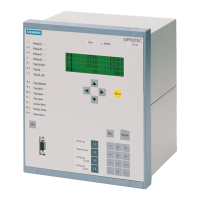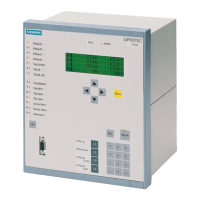Functions
2.42 Monitoring Functions
SIPROTEC, 7UM62, Manual
C53000-G1176-C149-7, Release date 03.2010
282
2.42 Monitoring Functions
The device is equipped with extensive monitoring capabilities - both for hardware and software. In addition, the
measured values are also constantly monitored for plausibility, therefore, the current transformer and voltage
transformer circuits are largely integrated into the monitoring.
2.42.1 Measurement Supervision
2.42.1.1 Hardware Monitoring
The device monitoring extends from the measuring inputs to the binary outputs. Monitoring circuits and proces-
sor check the hardware for malfunctions and inadmissible conditions (see also Table 2-14).
Auxiliary and Reference Voltages
The processor voltage of 5 VDC is monitored by the hardware since if it goes below the minimum value, the
processor is no longer functional. In that case the device is put out of operation. When the normal voltage re-
turns, the processor system is restarted.
Failure or switching off the supply voltage removes the device from operation and a message is immediately
generated by the "life contact" (an alternatively NO or NC contact). Brief auxiliary voltage interruptions of less
than 50 ms do not disturb the operational readiness of the device (for nominal auxiliary voltage ≥ 110 VDC).
The processor monitors the reference voltage of the ADC (analog-to-digital converter). In case of inadmissible
deviations the protection is blocked; persistent faults are signalled (indication: „Error A/D-conv.“).
Buffer Battery
The buffer battery, which ensures operation of the internal clock and storage of counters and messages if the
auxiliary voltage fails, is periodically checked for charge status. If it is less than an allowed minimum voltage,
then the „Fail Battery“ message is issued.
If the device is isolated from the auxiliary voltage for several hours, the internal back-up battery is switched off
automatically, i.e. the time is not registered any more. Messages and fault recordings however are kept stored.
Memory Components
All working memories (RAMs) are checked during start-up. If a fault occurs in this process, the start is aborted
and an LED starts flashing. During operation the memories are checked by means of their checksum.
For the program memory (EPROM), the cross-check sum is cyclically generated and compared to a stored ref-
erence program cross-check sum.
For the settings memory, the cross-check sum is formed cyclically and compared to the cross-check sum that
is freshly generated each time a setting process takes place.
If a fault occurs the processor system is restarted.
Probing
The sampling frequency and the synchronism between the internal buffer modules is continuously monitored.
If any deviations cannot be removed by renewed synchronisation, then the processor system is restarted.

